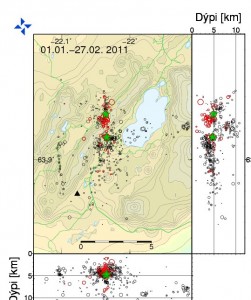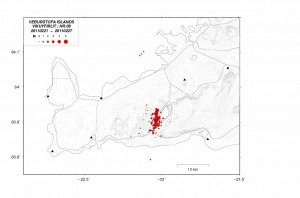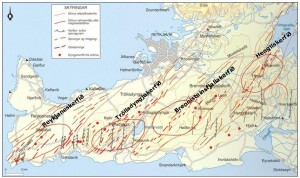Today has been interesting in regards to the earthquake activity in Krýsuvík volcano. But today there have been well over 800 earthquakes (far as I can tell). Over the past few hours the earthquake activity has slowed down a little bit. But far as I can tell it is far from over and might start to pick up again at any time and with no warning at all.
Icelandic Met Office released a picture of the earthquake activity in Krýsuvík volcano so far for the year 2011.

Black circles are earthquakes up to 26th of February. Red ones are earthquakes on the 27th February. Picture is from Icelandic Met Office web site and copyright of this picture belongs to them.
Here is a picture of the location of the earthquakes so far.

Picture is from Icelandic Met Office web site and copyright of this picture belongs to them.
Please note that this image does not have all the earthquakes that have been recorded in Krýsuvík volcano today.
More information about volcanoes in Reykjanes can be found here, in Icelandic.
Here is a picture, with fissure swarms and other things related to the four volcanoes that are on the Reykjanes Peninsula in Iceland.

Picture is from here. Copyright of this picture belongs to however owns it. Please note that I use this picture in a educational purpose on this web site. If there are any issues with the use of this picture. Please email me here: jonfr@8930a1.talbot.shared.1984.is
I expect that this earthquake activity is going to continue in the coming hours. But it is impossible to know when it stops.
Click on the pictures to see higher resolution of them.
Blog post updated at 04:12 CET on 28.02.2011. Title of this blog post is fixed.
Blot post updated at 13:40 CET on 28.02.2011. Spelling error fixed.

And, since we are waiting to see what happens next.
A Time v Latitude and a Time v Longitude plot. Older events are at the bottom, the newest are at the top. The tail end of the previous cluster in this swarm is the bottom group.
Time v Latitude
http://i52.tinypic.com/69hoaq.png
Time v Longitude
http://i54.tinypic.com/314ryo4.png
YAY!!! it mangled the timestamps.
Un-mangled version.
Lat
http://i52.tinypic.com/b7z6vt.png
Lon
http://i56.tinypic.com/zsv504.png
Each swarm has a slightly different spray.
The following might interest http://tinyurl.com/66o4r2f
Source http://hraun.vedur.is/ja/google/kmls/storir_1706-1990.kml
There is a storm in the area at the moment. So smaller earthquakes can be masked by it. Wind speed is going up to 20m/s.
Jon, could you translate the top 2 lines in this legenda:
http://icelandgeology.net/wp-content/uploads/2011/02/eldstodvakerfin_fjogur.jpg
The thin brown stripes and the red stripes.
Brown line – volcanic system, the central volcano and its fissures
Red line – outline of a central volcano
So the Krysuvik volcanic system reaches within urban Reykjavik? Never knew that.
Yes, that explains small quakes in Mosfellsdalur, Geldinganes etc.
Where did all the earthquakes go? Pulled by IMO for review, perhaps?
http://i.imgur.com/DApDe.jpg
Gone in the wind…
Well I think there were lots of events that were ghost quakes and needed to be reviwed.
If you notice, the ones that are left are all 99 % quality.
The might be back. At least, some of them
No, there are still many low-quality quakes left.
If I look at the IMO website the swarm seems to have been heavily reduced and the 3.0+ has been removed.
http://en.vedur.is/earthquakes-and-volcanism/earthquakes/reykjanespeninsula/
Have they been reviewed and corrected? Seems like the quality is still low on some of these.
No, yesterday’s quakes were all there and most of them were correct, proof is Jon’s helicorder and people’s testimonies. I have no idea why they have been removed.
They must have severe problems with the system and/or their procedures…
“Nothing to see here, move along”
I’ve heard that before…
I can understand why a lot of the EQs would have been removed, but to remove the entire set from 1pm – midnight including the big ones that were picked up by the helicorders would seem to imply a fair number will be coming back later today. I noticed that a lot of the EQs yesterday afternoon were 90,01 – 90,05 in quality – what does that quality figure mean? Is it a confidence percentage based on statistical likelihood or based on other factors such as recordings from multiple seismograms?
It means that men don’t trust computer generated data, so they have to go through man made calculation in order to confirm them manually, and then they will be brought back, which I hope they will be doing soon. Some may disappear, others will vary in their magnitudes.
But all will have a better quality mark: 99 ,0
The rest will be left for the trolls.
So this isn´t so bad swarm what it first looks? Over half EQs is removed and looks like that it´s ending now.
The swarm you saw yesterday was real. The quakes might have been a bit stronger/weaker but overall it was correct. (except for the location)
So yes, it was that ‘bad’.
Ok.
And sorry my bad english 🙂
There’s text on vedur.is that (when put through Google translate gives)
Last night we went to reduce seismicity and the Kleifarvatn cycle seems to be to fade out.
I’m guessing there’s some nuances in the original Icelandic but it seems to basically say “We’re lowered the figures and got rid of the problem!”
Somebody could give a better translation for:
“Í gærkvöldi fór að draga úr skjálftavirkni við Kleifarvatn og virðist hrinan vera að fjara út.”
This means that the earthquake swarm appears to be fading out.
The exact translation, more or less.
“Last night earthquake activity with Kleifarvatn lake started to drop and the activity appears to be fading out”.
One just came back !! A 2.4 at 20:04 in the middle of the gap.
TonyM,
Or, Springfield nuclear power station is going into meltdown, so Homer Simpson switched off the dials and there’s nothing to worry about!
Lots of quakes from yesterday are listed with a Ml of -9.0 on http://hraun.vedur.is/ja/englishweb/eqlist.html. I assume, that they are being re-evaluated at the moment…
“Í gærkvöldi fór að draga úr skjálftavirkni við Kleifarvatn og virðist hrinan vera að fjara út.”
“Yesterday evening we reduced the seismicity and the Kleifarvatn cycle seems to be coming to an end”.
This is what i could get out of it.
It seems the number of events has been reduced. Why I dont know. Maybe it has something to do with the equipment capacity? When overloaded with information it shows erroneous data?
Number one reason for IMO removal of yesterdays quakes is overload on IMO’s computers.
All references to IMOs pics from yesterday in the (online) papers have been removed because they were not static, but live (refreshed every time). Take static pics if you want to keep data at some point, give the link to live data so mainframe computers are not overloaded.
Looks like it’s more a matter of their equipment not being able to record that many so close together (consecutively) or that that speed/acceleration? Also looks like their graph format can’t fit as many quakes as the plot formats? Eh, what do I know- I’m not a scientist.
Sorry typo “at that”. Does anyone care to speculate as to “how many” more cycles/big swarms we might see before an eruption?
The earthquakes has now been restored at IMO.
Well, they are back again! See http://en.vedur.is/earthquakes-and-volcanism/earthquakes/reykjanespeninsula/
I hope they can make up their mind someday… ;o)
So what did they do to them? The quality numbers look about the same.
I think its a computer problem when too much data comes in.
The swarm starting to pick up some speed again?
It seems to have done so. If this increase holds the area might be picking up activity again.
The tremor also picks up again.
http://hraun.vedur.is/ja/oroi/kri.gif
What causes the 12-hour period on the tremor?
Dunno. Tides are every 12 hours, but it is not necesarily that.
Jón gave a better translation upstream:
“Last night earthquake activity with Kleifarvatn lake started to drop and the activity appears to be fading out”.
¤%&%&(&**!!
perhaps I should register and get rid of the Captcha.
The one above was meant to be a reply to Daniel.
I’m new to volcano watching, but very interested in the recent activity. Is there any way to tell from the available data whether the ongoing quakes are low or high frequency, and whether the “wagging” that I’ve read about is going on inside Krýsuvík, which might indicate a pending eruption? These questions are based on a bit of reading and a lot of ignorance, so keep that in mind if those are dumb questions. Thanks.
The tremor plot on Icelandic Met Office web site shows that the earthquakes have high frequency component mostly.
But it is hard to know if there is going to be a eruption in Krísuvík volcano due to how long it is since it last erupted.
Can’t “wag” with out a pipe. Krýsuvík is a fissure row. There would have to be some way for an annulus of gas to form around the outside of a moving column of magma. (the foamy part around the outside) That’s the mechanics of the “wagging” phenomena in the paper.
That structural layout is common to the typical volcano (Katla, Ranier, Merapi) but I don’t think it fits with this style of system. (plates moving apart and what ever magma is there oozing up. (oozing is a bad term, I mean that it’s much less violent than a typical stratovolcano)
Ah. Thanks for the info. (And to Jon!)
http://www.icenews.is/index.php/2011/02/28/earthquakes-in-southwest-iceland-parrots-unhappy/
“It is always headline news when an earthquake is felt in the Icelandic capital, Reykjavik — even though such events are surprisingly regular. Over 500 small quakes have shaken southwest Iceland yesterday alone.
The quakes are in the region of Kleifarvatn, a lake on the geologically-active Reykjanes peninsula. a 4.2 magnitude quake at around 17.30 yesterday was widely felt by people in Reykjavik; as was another one at 09.00 which had a magnitude of four.
The town and municipality of Hafnarfjordur (sometimes incorrectly thought of as a Reykjavik suburb) is even nearer to the epicentre and residents there are actually getting used to the earthquakes which are always quite regular and have been nearly constant since Thursday.
Hafnarfjordur’s Asvallalaug swimming pool is not far from the epicentre. Dorota Solecka was lifeguarding there at the time of the 09.00 quake. She described how all the doors and windows in the lifeguarding tower started to shake — but added that it was not a problem and was over in just a few seconds.
RUV also reported that Thorunn Margret Jonasardottir’s parrots were woken by an earthquake and did not like it one bit. Jonasardottir explained that they never usually make any noise at night, but started going crazy in the early hours of Sunday. She turned the light on near their cage and then went back to bed.
Geologists say they are not concerned by the series of earthquakes, as seismic activity is common on Reykjanes. They say there is no evidence of volcanic activity, Visir.is reported.”
😀
Any one doing any gas studies in the area? I mean volcanic gases. That would tell the
tale and also the fact that no one is getting excited…
I guess geochemists will now take a look at this area. But since this swarm peaked yesterday, I would expect these results today.
European capital city hit by hundreds of earthquakes – Interesting to note that not a word of this event has appeared in the UK news. If it wasn’t for sites like this, we would never know about this over here. Thank you Jon!
Well, Iceland was to one country promising for cash, but sent us ash instead… ;o)
The swarm is ending or it can increase more than yesterday?
New blog post is up! 🙂